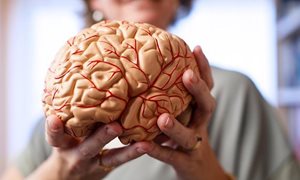
People with Parkinson's disease regularly have difficulty walking and use different strategies to improve gait. Until now it was unknown how these walking strategies caused the walking improvement. Brain research of Radboud university medical center shows - for the first time - that there are multiple 'routes' in the brain that control walking, which can take over if the main route is affected by Parkinson's.
In people with Parkinson's disease the 'autopilot' functions less well. This causes problems with movements that you normally don't have to think about - like walking. Fortunately, people with Parkinson's can use creative strategies to overcome these walking problems, as shown in previous research by the Radboudumc. These strategies, divided into seven categories, range from walking using internal stimuli such as counting, to observing others' movements and imitating them. For example, some people walk much better to the rhythm of music.
The researchers wanted to find out what happens in the brain when people engage these strategies. "We were driven by curiosity," explains rehabilitation physician and final author Jorik Nonnekes. "We know that when people learn something new, they use different brain areas compared to when they do things automatically. Our hypothesis was that this works similarly for walking with walking strategies in people with Parkinson’s disease, and that they therefore engage other brain areas to compensate for the faulty autopilot. This had never been explored before."
Measuring brain activity using EEG
Using EEG (brain videos), the brain activity of eighteen people with Parkinson’s disease and walking problems was measured as they walked on a treadmill. This showed that when the participants successfully used a strategy, they activated additional brain regions compared to walking without a strategy. Exactly which brain areas were activated differed per strategy. When counting while walking (an internal stimulus) people used the frontal brain areas more than when walking without the use of a strategy. In contrast, when walking to the rhythm of a metronome (an external stimulus) and observing the movements of others, the lobes on the side and back of the brain were activated more. "The fact that each strategy seems to have a unique mechanism of action could potentially explain why one strategy works well in one person, but does not improve walking at all in another," explains PhD candidate and first author Anouk Tosserams.
More knowledge about creative strategies
The researchers want to convey to people with Parkinson’s disease that they can benefit greatly from using these strategies. Previous research has shown that most people are far from familiar with all available strategies. Nonnekes: "For many people, Parkinson’s disease impairs walking because of a defective 'autopilot' that normally controls walking. We have now shown that there are still sufficient alternative circuits in the brain that can initiate walking. If people are aware of this and learn about the available strategies, they can make full use of these alternative pathways."
The seven walking strategies
These are the seven walking strategies previously mapped:
- Internal stimuli, such as counting while walking;
- External stimuli, such as walking to the beat of a metronome or stepping over lines on the ground;
- Changing balance, such as making wider turns;
- Changing mental state, such as reducing stress;
- Observing and visualizing movements, such as watching another person walk and mimicking their movements;
- Adopting new walking patterns, such as raising the knees high or walking backwards;
- Other forms of using the legs, such as biking or skateboarding.
This study looked at internal and external stimuli and observing movements.
About the publication in Annals of Neurology
Cortical correlates of gait compensation strategies in Parkinson's disease - Anouk Tosserams, Vivian Weerdesteyn, Tess Bal, Bastiaan R. Bloem, Teodoro Solis-Escalante, and Jorik Nonnekes. DOI: 10.1002/ana.26306.
-
Want to know more about these subjects? Click on the buttons below for more news.
More information
Pauline Dekhuijzen

wetenschaps- en persvoorlichter
Related news items

NWO Stevin Prize for expert on Parkinson’s disease Bas Bloem Major scientific prize for societal impact on research into Parkinson's disease
17 June 2022 Neurologist Bas Bloem of Radboudumc receives this year’s Stevin Prize of the Dutch Research Council (NWO). The Stevin Award is the highest distinction in science for a researcher in the Netherlands who has achieved particular success in the area of knowledge utilization for society. go to page
Aerobe exercise has a positive effect on brain function in Parkinson's disease patients
18 January 2022 Radboudumc researchers have shown that the brain function of patients with Parkinson's disease improved with regular exercise, which seems to strengthen the connections between different brain areas, while inhibiting brain shrinkage. go to page
Tiny blood vessels, big problems Radboudumc receives grant for international collaboration
3 November 2021 The Radboudumc, together with the University of Cambridge, receives a grant of €1.8M from three collaborating cardiac foundations for international research into the small blood vessels in the brain. This study will be led by Neurologist Frank-Erik de Leeuw and internist Niels Riksen. go to page


